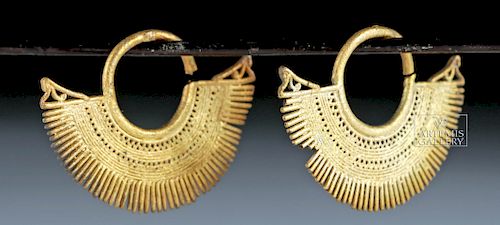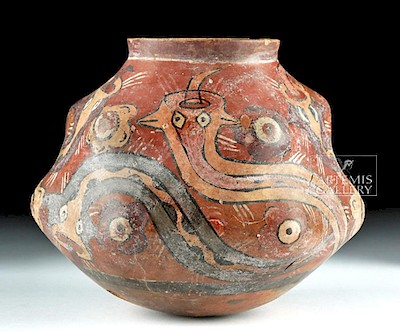Matched Pair Sinu 12K Gold Earrings - 1.9 g
Lot 160a
About Seller
Artemis Gallery
686 S Taylor Ave, Ste 106
Louisville, CO 80027
United States
Selling antiquities, ancient and ethnographic art online since 1993, Artemis Gallery specializes in Classical Antiquities (Egyptian, Greek, Roman, Near Eastern), Asian, Pre-Columbian, African / Tribal / Oceanographic art. Our extensive inventory includes pottery, stone, metal, wood, glass and textil...Read more
Estimate:
$800 - $1,200
Absentee vs Live bid
Two ways to bid:
- Leave a max absentee bid and the platform will bid on your behalf up to your maximum bid during the live auction.
- Bid live during the auction and your bids will be submitted real-time to the auctioneer.
Bid Increments
| Price | Bid Increment |
|---|---|
| $0 | $25 |
| $300 | $50 |
| $1,000 | $100 |
| $2,000 | $250 |
| $5,000 | $500 |
| $10,000 | $1,000 |
| $20,000 | $2,500 |
| $50,000 | $5,000 |
| $100,000 | $10,000 |
| $200,000 | $20,000 |
About Auction
By Artemis Gallery
Jul 5, 2018
Set Reminder
2018-07-05 10:00:00
2018-07-05 10:00:00
America/New_York
Bidsquare
Bidsquare : Ancient | Ethnographic | Fine Art
https://www.bidsquare.com/auctions/artemis-gallery/ancient-ethnographic-fine-art-3306
Featuring classical antiquities, ancient and ethnographic art from cultures encompassing the globe. Artemis Gallery info@artemisgallery.com
Featuring classical antiquities, ancient and ethnographic art from cultures encompassing the globe. Artemis Gallery info@artemisgallery.com
- Lot Description
Pre-Columbian, Colombia, Sinu, ca. 10th to mid 16th century CE. Finely crafted from 12 karat gold, this pair of crescent shaped earrings was skillfully cast via the lost wax (cire perdue) process. Each has an intricate composition of two filigreed (displaying a delicate lacelike openwork continuous weave motif) registers separated by striated bands. Perched on the ends of each are twin stylized, long-beaked birds. The suspension ring on top of each is thick and substantial. Size: 1.125" W x .75" H (2.9 cm x 1.9 cm); Weight: 1.9 grams
Similar examples have been written about by Heidi King of the Metropolitan Museum of Art in "The Art of Precolumbian Gold." King writes, "Ear ornaments are ubiquitous in the personal jewelry of ancient America. South American peoples were especially fond of their use, and, for millennia, they made the ornaments in an enormous variety of pattern, size, and material. Many of the shapes and sizes of these ornaments are so extraordinary that to people of twentieth-century sensibility they seem unwearable. That is not the case with the pairs of ear pendants here, for they conform to a familiar, present-day pattern. They could be worn, more or less, comfortably, hanging from the earlobes. The delicate wire work of which they are composed gives the ornaments a light and graceful aspect of great appeal. Indeed they were much admired in ancient times too, for this type of ornament was made in some quantity."
King continues, "During the sixteenth century, the Sinu region of Caribbean Colombia, where ornaments of this type have been identified, was very rich in gold, a fact much commented upon by the Spanish conquerors. The desire for gold soon led them to search not only the living but the dead, and the looting of ancient graves began. Gold objects had been important mortuary offerings in the Sinu for centuries." (The Art of Precolumbian Gold: The Jan Mitchell Collection" edited by Julie Jones. Boston: Little Brown & Company, 1985, p. 164) Goldwork that survived such plundering is understandably rare.
Provenance: private East Coast, USA collection
All items legal to buy/sell under U.S. Statute covering cultural patrimony Code 2600, CHAPTER 14, and are guaranteed to be as described or your money back.
A Certificate of Authenticity will accompany all winning bids.
We ship worldwide and handle all shipping in-house for your convenience.
#133279Very slight bending to form, with some losses to termini of a few feather-like motifs at the lower border of the design. Hooks are not flexible and missing clasps, but a reputable jeweler could make these wearable by affixing a new setting.Condition
- Shipping Info
-
All shipping is handled in-house for your convenience. Your invoice from Artemis Gallery will include shipping calculation instructions. If in doubt, please inquire BEFORE bidding for estimated shipping costs for individual items.
-
- Buyer's Premium



 EUR
EUR CAD
CAD AUD
AUD GBP
GBP MXN
MXN HKD
HKD CNY
CNY MYR
MYR SEK
SEK SGD
SGD CHF
CHF THB
THB












